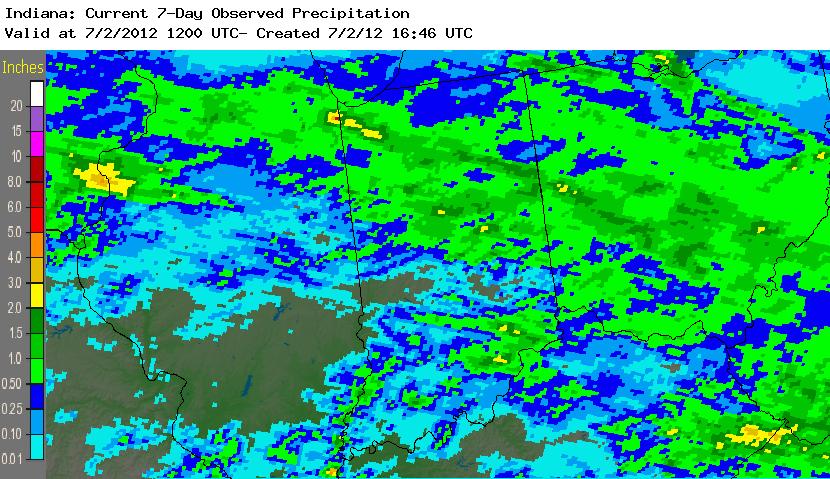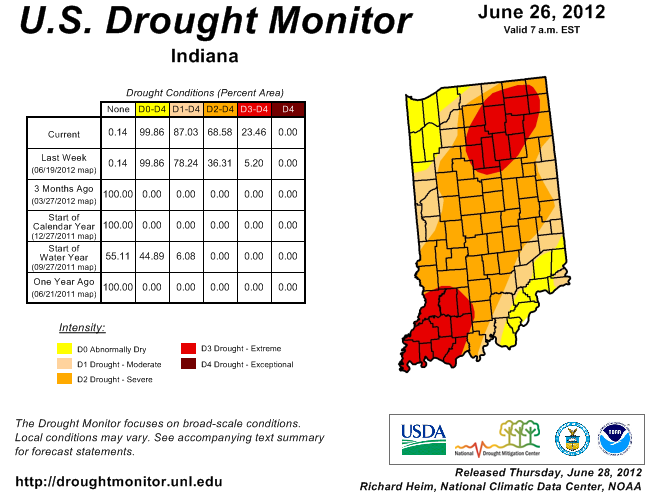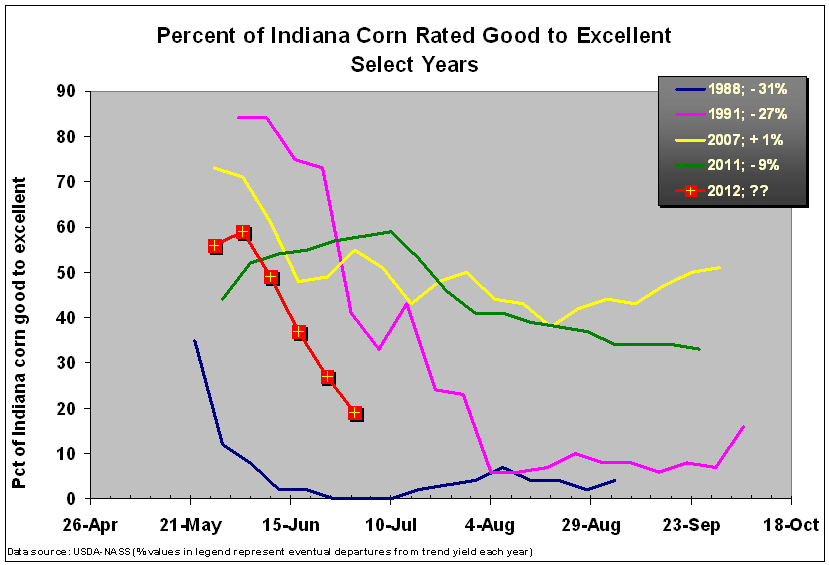2 July 2012
URL: http://www.kingcorn.org/news/articles.12/Million-0702.html
Million Dollar Rain for Some Fields; Not All
R.L. (Bob) Nielsen
Agronomy Dept., Purdue Univ.
West Lafayette, IN 47907-2054
Email address: rnielsen
at purdue.edu

Fig. 1. Seven-day cumulative rainfall throughout Indiana; as of 7am on
2 July 2012. Source of rainfall estimates: http://water.weather.gov/precip.

Fig. 2. U.S. Drought Monitor map of Indiana drought severity; as of 6/26/12.
Source of image: http://droughtmonitor.unl.edu.

Fig. 3. Percent of Indiana corn rated as good to excellent for select years
including 2012 (as of 1 July). Data source: USDA-NASS.
This past weekend, storms rumbling through the state left behind much-needed rainfall. The rainfall amounts varied quite a bit as is typical of summer thunderstorm patterns, but some areas of the state have received 1 to 2 inches over the past seven days (Fig. 1).
In the midst of a severe drought, any chance rainfall is welcomed with open arms. However, the optimism generated by the rainfall needs to be tempered by the severity of the drought throughout Indiana (Fig. 2) and the continued short-term forecast for excessively hot temperatures for much of the state during a period of time when many of the acres will be pollinating.
There is no question that, for some fields, the recent rains have been "million dollar" rains from the standpoint that they offered some relief for fields coming into the pollination period. However, the drought has not yet been "broken" and the state's corn crop will require timely rainfall in meaningful amounts to avoid serious yield losses this fall.
Corny Trivia: A million dollars does not go far in terms of Indiana's most important row crop. One million dollars divided by $6.50 corn equals roughly 154,000 bushels. Take that result and divide by the acres of corn produced in, say, White County and that "million dollar" rain equals a yield increase of about 1 bushel per acre (bpa) for every acre in White County. A lot of money in total, but not much of a yield increase in the big scheme of things.
The latest USDA estimates of corn crop condition indicates the crop is continuing to slide downhill (USDA-NASS, 2 July 2012). As of July 1, only 19 percent of Indiana's corn crop was rated as good to excellent. That estimate of statewide crop condition is as low as it has been for this time of the season since the "Great Drought of 1988" (Fig. 3).
The decrease in corn crop conditions around the state reflected in the July 1 estimates, combined with the crop conditions throughout June, would suggest that statewide corn grain yield could average only 140 bpa or 13% below the estimated 2012 trend yield of 162 bpa. That departure from trend, if it comes to pass, would be the sixth worst departure from trend since 1980. For comparison, the five other worst years were 1983 (-34%, drought), 1988 (-31%, drought), 1991 (-27%, drought), 1995 (-15%, drought), and 2002 (-16%, late planting, cool summer and fall).
RLN Note: The estimated trend yield of 162 bpa for Indiana in 2012 is based on a historical trend line beginning in 1955 (R2 = 0.82). The estimate of yield loss is based a simple linear relationship between 19 years of crop condition ratings in June/July (including 1988 and 1991) and the associated grain yields statewide (R2 = 0.51)
As I indicated last week (Nielsen, 2012b), the stress of this year's "big hot and dry" on the corn crop escalated greatly with the advent of the excessive temperatures in mid-June. The resumption of those hot temperatures in the coming days will continue to pressure this crop, especially in areas that did not receive the welcome rains of this past weekend. Where rainfall was received, pollination may technically succeed, but the risk of kernel abortion in the few weeks following the end of pollination will be high for those fields where severe drought stress continues or resumes.
I also remind growers they can assess the relative degree of success of pollination in individual fields shortly after pollen shed is complete by sampling ears and conducting the simple "ear shake" test (Nielsen, 2012a). Later in the season, growers can estimate grain yield in individual fields by estimating ears per acre and kernels per ear (Nielsen, 2011b).
Pray for rain or turn on the irrigation.
Related reading
National Weather Service. 2012. AHPS Precipitation Analysis. http://water.weather.gov/precip [URL verified June 2012].
Nielsen, RL (Bob). 2008. Grain Fill Stages in Corn. Corny News Network, Purdue University. http://www.kingcorn.org/news/timeless/GrainFill.html [URL verified June 2012].
Nielsen, RL (Bob). 2011a. Effects of Stress During Grain Filling in Corn. Corny News Network, Purdue Univ. http://www.kingcorn.org/news/timeless/GrainFillStress.html [URL verified June 2012]
Nielsen, RL (Bob). 2011b. Estimating Corn Grain Yield Prior to Harvest. Corny News Network, Purdue Purdue Univ. http://www.kingcorn.org/news/timeless/YldEstMethod.html [URL verified June 2012].
Nielsen, RL (Bob). 2012a. A Fast & Accurate Pregnancy Test for Corn. Corny News Network, Purdue Univ. http://www.kingcorn.org/news/timeless/EarShake.html [URL verified June 2012]
Nielsen, RL (Bob). 2012b. Hot & Dry: Stress on the corn crop escalates. Corny News Network, Purdue Univ. http://www.kingcorn.org/news/articles.12/HotDryMidSeason-0625.html [URL verified July 2012].
Nielsen, RL (Bob). 2012c. Next Big Hurdle: Pollen Shed and Silking. Corny News Network, Purdue Univ. http://www.kingcorn.org/news/articles.12/Hurdle-0617.html [URL verified June 2012]
Nielsen, RL (Bob). 2012d. Resources for Managing or Assessing Drought-Stressed Field Crops. Corny News Network, Purdue Univ. http://www.kingcorn.org/cafe/drought [URL verified June 2012]
USDA-NASS. 2012. Crop Progress. USDA Nat'l Ag Statistics Service. http://usda.mannlib.cornell.edu/MannUsda/viewDocumentInfo.do?documentID=1048 [URL verified June 2012].

